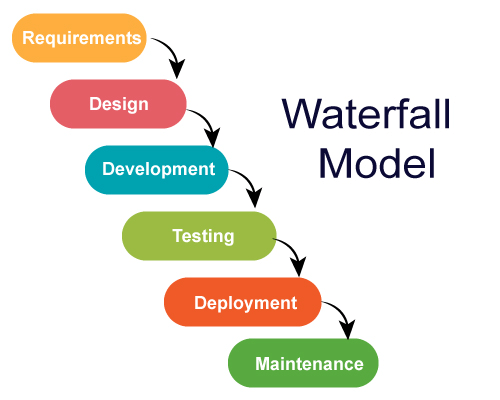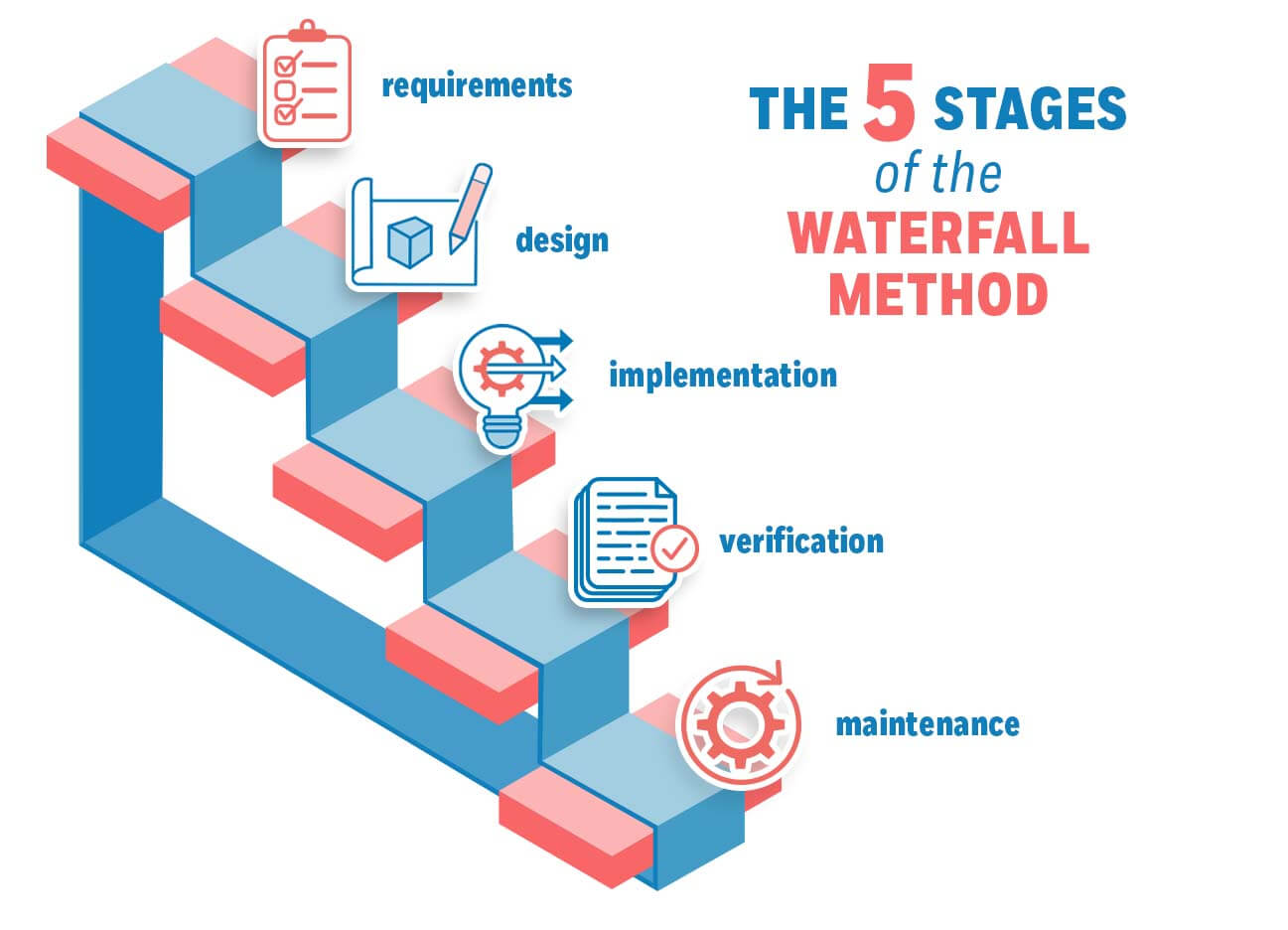what is waterfall model? Its advantages & disadvantages.
Waterfall model
is a sequential software development process that follows a linear and rigid approach to project management. It was first introduced by Dr. Winston W. Royce in 1970 in his paper titled "Managing the Development of Large Software Systems." The Waterfall model gained popularity due to its simplicity and ease of use, especially in projects where requirements are well-defined and unlikely to change.
In the Waterfall model, the development process is divided into distinct phases, each of which is completed before moving on to the next one. These phases typically include requirements gathering, system design, implementation, testing, deployment, and maintenance. The name "Waterfall" is derived from the visual representation of this model, where progress flows sequentially downwards, just like a waterfall.
To provide a comprehensive understanding of the Waterfall model, we will explore each phase in detail, discuss its advantages and disadvantages, and analyze its applicability in different scenarios. Additionally, we will examine the criticisms and limitations of the Waterfall model, as well as alternative software development methodologies that have emerged to address its shortcomings.
1. Requirements Gathering
The requirements gathering phase is the initial step in the Waterfall model. During this phase, project stakeholders, including clients, users, and developers, collaborate to define and document the system's functional and non-functional requirements. This process involves conducting interviews, workshops, and surveys to gather information and establish a clear understanding of the project's goals and objectives.
Advantages
- Well-defined requirements help ensure that the project stays on track and meets stakeholders' expectations.
- A detailed requirements document serves as a reference point throughout the development process, minimizing the risk of misunderstandings or scope creep.
- Clear requirements facilitate accurate cost estimation, resource allocation, and project scheduling.
Disadvantages
- The rigid nature of the Waterfall model makes it challenging to accommodate changing or evolving requirements.
- Stakeholders may not have a complete understanding of their needs at the beginning of the project, leading to potential inaccuracies in the requirements documentation.
- The lengthy requirements gathering phase can delay project initiation, especially when dealing with complex systems or large-scale projects.
2. System Design
Once the requirements are gathered and approved, the system design phase begins. In this phase, the software architecture and overall system structure are defined. The design phase involves creating high-level and low-level designs, specifying the software components, modules, and their interrelationships. This phase also includes designing the user interface, database structure, and external interfaces.
Advantages
- A well-designed system ensures that all functional and non-functional requirements are addressed adequately.
- Clear and detailed design documentation helps developers understand the system's structure and aids in implementing the software accurately.
- Early design decisions can identify potential issues and risks, allowing for their mitigation before proceeding further in the development process.
Disadvantages
- The design phase is heavily dependent on the accuracy of the requirements documentation. Any discrepancies or misunderstandings may lead to flawed designs.
- Late-stage design changes can be costly and time-consuming to implement, as they often require modifications throughout the system.
- The design phase is primarily focused on the theoretical aspects of the software, which may not fully consider real-world constraints or technical limitations.
3. Implementation
In the Waterfall model, the implementation phase follows the design phase. This phase involves translating the design specifications into executable code. Developers write and test the software modules, following the architectural guidelines and design documents created earlier. The implementation phase is typically divided into smaller tasks or modules, allowing for parallel development and easier coordination.
Advantages
- The sequential nature of the Waterfall model ensures that developers have a clear understanding of the requirements and design specifications before starting the implementation.
- Independent module development allows for concurrent work, reducing the overall project duration.
- The implementation phase provides a tangible output, making it easier to
track progress and identify any potential deviations from the initial plan.
Disadvantages
- The Waterfall model assumes that all design decisions are made upfront, which may limit the flexibility to adapt to changing requirements or technological advancements.
- Limited user involvement during implementation can result in a mismatch between user expectations and the final product.
- Testing is typically deferred to the next phase, which can lead to the accumulation of errors or bugs that are discovered only during the testing stage.
4. Testing
The testing phase focuses on identifying defects and ensuring that the software meets the specified requirements. Testers execute various test cases, including functional, performance, and security tests, to validate the software's behavior. The primary goal of testing is to detect and fix any defects before the software is deployed to end-users.
Advantages
- Testing helps identify and rectify errors early in the development process, reducing the cost and effort required for bug fixing during later stages.
- Systematic testing ensures that the software meets the desired quality standards and performs as expected.
- Test documentation provides traceability, enabling developers to track and resolve issues effectively.
Disadvantages
- Testing is often conducted late in the Waterfall model, which can result in significant rework if critical defects are identified.
- Limited user involvement during testing may lead to the overlooking of important use cases or scenarios.
- The sequential nature of the Waterfall model can make it challenging to incorporate changes or updates discovered during the testing phase.
5. Deployment
The deployment phase involves delivering the software to the end-users or customers. In the Waterfall model, this phase occurs only after the development and testing stages are complete and the software has been deemed ready for production use. The deployment process includes installation, configuration, and any necessary data migration.
Advantages
- The sequential approach of the Waterfall model allows for thorough testing and bug fixing before deployment, reducing the risk of critical issues in the production environment.
- Deployment plans and procedures can be carefully crafted and documented, ensuring a controlled and efficient rollout of the software.
- Stakeholders have a clear understanding of the software's features and behavior before it is released, enabling effective user training and support.
Disadvantages
- Delays or issues discovered during deployment may require changes to the previously completed phases, leading to additional costs and efforts.
- The rigid structure of the Waterfall model can make it difficult to adapt to unforeseen circumstances or evolving user requirements during the deployment stage.
- End-users may have limited opportunities for providing feedback or influencing the final product, potentially resulting in a mismatch between user expectations and the deployed software.
6. Maintenance
The maintenance phase involves ongoing support, bug fixes, and enhancements to the software after its deployment. In the Waterfall model, maintenance is considered a separate phase, which can extend over an extended period. Maintenance activities include addressing user-reported issues, performing updates or patches, and implementing new features or functionality.
Advantages
- The maintenance phase allows for continuous improvement and refinement of the software based on user feedback and changing needs.
- The sequential nature of the Waterfall model ensures that maintenance efforts are well-documented and organized, making it easier to track and manage changes over time.
- Maintenance activities can be planned and scheduled, ensuring that resources are allocated efficiently to address the most critical issues or enhancements.
Disadvantages
- The Waterfall model's linear structure can make it challenging to accommodate frequent or significant changes during the maintenance phase.
- Lack of user involvement during maintenance can lead to delayed or inadequate responses to user requests or issues.
- Maintenance efforts can become more time-consuming and complex as the software evolves, potentially resulting in higher costs and extended timelines.
Criticisms and Limitations of the Waterfall Model
Despite its initial popularity, the Waterfall model has faced criticisms and limitations over time. Some of the key criticisms include
:
1. Lack of flexibility: The Waterfall model's sequential and rigid nature makes it challenging to accommodate changing requirements, leading to potential delays and cost overruns.
2. Limited user involvement: The model's linear structure often restricts user participation to the early stages, which can result in a disconnect between the final product and user expectations.
3. Late-stage error detection: Deferring testing until the end of the development cycle can result in the accumulation of errors or bugs, making them more challenging and costly to fix.
4. Documentation overload: The Waterfall model relies heavily on comprehensive documentation, which can be time-consuming and may not always reflect the evolving nature of software development.
Alternative Methodologies
In response to the limitations of the Waterfall model, various alternative methodologies have emerged, aiming to address flexibility, user collaboration, and iterative development. Some notable alternatives include:
1. Agile methodologies: Agile approaches, such as Scrum and Kanban, emphasize iterative and incremental development, frequent user feedback, and adaptability to changing requirements.
2. Lean development: Lean development focuses on reducing waste and maximizing value delivery by eliminating non-essential activities and emphasizing continuous improvement.
3. Spiral model: The Spiral model combines elements of the Waterfall model and iterative development, allowing for frequent prototyping, user evaluation, and risk mitigation.
4. DevOps: DevOps emphasizes collaboration and integration between development and operations teams, enabling faster and more reliable software delivery and deployment.
These alternative methodologies provide organizations with more flexible and adaptive approaches to software development, allowing for faster time-to-market, improved user satisfaction, and enhanced quality.
Conclusion
The Waterfall model is a sequential software development process that has been widely used over the years. It offers a structured and systematic approach, suitable for projects with well-defined requirements and limited changes. However, the model has faced criticism for its lack of flexibility, limited user involvement, and late-stage error detection. As software development has evolved, alternative methodologies like Agile, Lean, Spiral, and DevOps have gained prominence, providing more adaptable and collaborative approaches to meet the demands of modern software development projects. Organizations must carefully assess their project requirements, constraints, and stakeholder expectations to determine the most suitable development methodology for their specific needs.




Comments